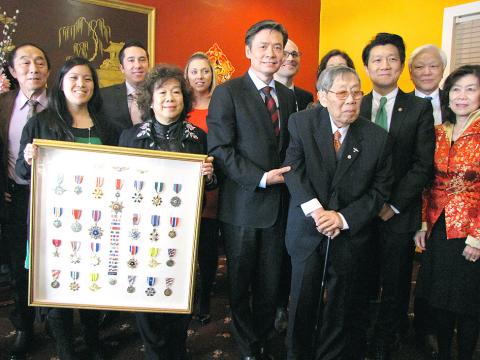The celebration of former American Volunteer Group (AVG) captain Lee Hsueh-yan’s (李學炎) 102nd birthday on Sunday, which turned into something of a state banquet, has revived people’s memories of the spectacular wartime exploits of the former air force major general.
Accompanied by dozens of family members, Lee celebrated his 102nd birthday on Sunday in New Jersey. The celebration was also attended by Representative to the US King Pu-tsung (金溥聰) and Republic of China (ROC) Defense Mission to the US director Li Hsien-sheng (黎賢聖).
On behalf of President Ma Ying-jeou (馬英九) and Air Force Chief of Staff Major General Liu Chen-wu (劉震武), King and Li presented gifts to wish the retired hero continued longevity and good health.

Photo: Nadia Tsao, Taipei Times
Major General Mike Tien (田在勱), who now serves as a consultant to King, also shared with Lee’s family his rich collection of historical materials pertaining to the legendary AVG, widely known as “the Flying Tigers.”
With scores of medals of honor to his name, Lee stepped out of the limelight in 1968, when he retired from military service as a major general.
Lee’s name was brought into the spotlight again in January, after one of his sons, Wei-Ping Andrew Lee (李為平), a US-based surgeon, made headlines for leading a high-profile double arm transplant on a 26-year-old US army infantryman who lost all his limbs in Iraq.
Deemed “living history,” Lee Hsueh-yan was involved in several defining moments in the nation’s past.
Following the conclusion of the Xian Incident in 1936, Lee Hsueh-yan was instructed to transport former Chinese premier Zhou Enlai (周恩來), who was then the Chinese Communist Party’s representative, from Yanan, in China’s Shananxi Province, to Xian to meet with Chiang Kai-shek (蔣介石) on the possibility of negotiating a temporary truce amid the Japanese invasion.
During World War II, Lee Hsueh-yan also led the first Bombardment Squadron of the Chinese-American Composite Wing in launching an air-raid attack on Nov.25, 1943 on a Japanese airfield in Shinchiku — in what is now Hsinchu — destroying 42 Japanese aircraft.
However, in addition to the former major general’s dedication to the nation, the Ma administration’s sudden interest in him is also thought to be politically motivated, in part by China’s apparent effort to latch onto the history of the Flying Tigers.
In recent years, China has sought to interview family members of deceased AVG members and collect historical materials regarding the volunteer air units, which were organized by the US government to assist Chiang’s government in fighting off Japan during the Second Sino-Japanese War.
China’s perceived attempt to incorporate the unit into its own history has allegedly irritated the ROC Air Force, which is said to be countering by holding a celebration in Hsinchu on Nov. 25 to mark the 70th anniversary of the unit’s Japanese base attack.
Another factor is said to be Taiwanese sovereignty, because Lee Hsueh-yan’s air raid victory coincided with the Cairo Conference in Cairo, Egypt, between Nov. 22 and Nov. 26, 1943. The Cairo Declaration, which demanded that Japan cede territories including Taiwan (Formosa) and Penghu (the Pescadores) to the ROC, is the basis for the ROC government’s sovereignty claim over Taiwan.

US climber Alex Honnold is to attempt to scale Taipei 101 without a rope and harness in a live Netflix special on Jan. 24, the streaming platform announced on Wednesday. Accounting for the time difference, the two-hour broadcast of Honnold’s climb, called Skyscraper Live, is to air on Jan. 23 in the US, Netflix said in a statement. Honnold, 40, was the first person ever to free solo climb the 900m El Capitan rock formation in Yosemite National Park — a feat that was recorded and later made into the 2018 documentary film Free Solo. Netflix previewed Skyscraper Live in October, after videos

NUMBERS IMBALANCE: More than 4 million Taiwanese have visited China this year, while only about half a million Chinese have visited here Beijing has yet to respond to Taiwan’s requests for negotiation over matters related to the recovery of cross-strait tourism, the Tourism Administration said yesterday. Taiwan’s tourism authority issued the statement after Chinese-language daily the China Times reported yesterday that the government’s policy of banning group tours to China does not stop Taiwanese from visiting the country. As of October, more than 4.2 million had traveled to China this year, exceeding last year. Beijing estimated the number of Taiwanese tourists in China could reach 4.5 million this year. By contrast, only 500,000 Chinese tourists are expected in Taiwan, the report said. The report

Temperatures are forecast to drop steadily as a continental cold air mass moves across Taiwan, with some areas also likely to see heavy rainfall, the Central Weather Administration (CWA) said. From today through early tomorrow, a cold air mass would keep temperatures low across central and northern Taiwan, and the eastern half of Taiwan proper, with isolated brief showers forecast along Keelung’s north coast, Taipei and New Taipei City’s mountainous areas and eastern Taiwan, it said. Lows of 11°C to 15°C are forecast in central and northern Taiwan, Yilan County, and the outlying Kinmen and Lienchiang (Matsu) counties, and 14°C to 17°C

STEERING FAILURE: The first boat of its class is experiencing teething issues as it readies for acceptance by the navy, according to a recent story about rudder failure The Hai Kun (海鯤), the nation’s first locally built submarine, allegedly suffered a total failure of stern hydraulic systems during the second round of sea acceptance trials on June 26, and sailors were forced to manually operate the X-rudder to turn the submarine and return to port, news Web site Mirror Daily reported yesterday. The report said that tugboats following the Hai Kun assisted the submarine in avoiding collisions with other ships due to the X-rudder malfunctioning. At the time of the report, the submarine had completed its trials and was scheduled to begin diving and surfacing tests in shallow areas. The X-rudder,